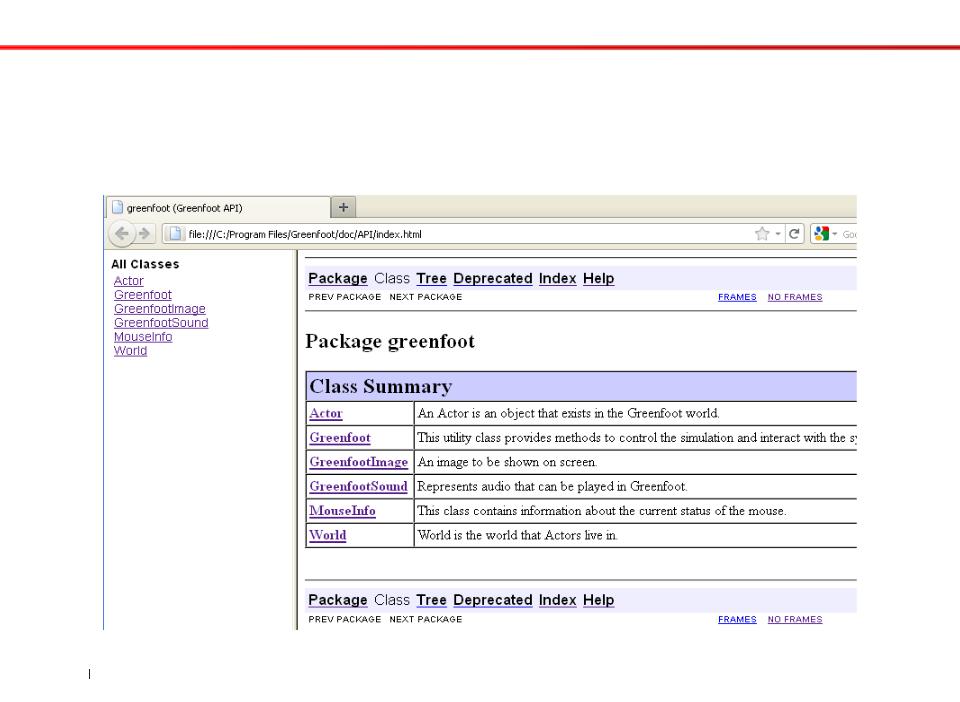
Greenfoot / JF_V02_S03_L05
.pdf
Java Fundamentals
Using Randomization and Understanding Dot Notation and Constructors
1Copyright © 2012, Oracle and/or its affiliates. All rights reserved.

Randomization, Dot Notation and Constructors
Overview
This lesson covers the following topics:
•Create randomized behaviors
•Define comparison operators
•Create IF-ELSE control statements
•Create an instance of a class
•Recognize and describe dot notation
2Copyright © 2012, Oracle and/or its affiliates. All rights reserved.

Randomization, Dot Notation and Constructors
getRandomNumber Method
•The getRandomNumber method is a static method that returns a random number between zero and a parameter limit.
•This method is used to eliminate predictability in your program.
•Method signature:
public static int getRandomNumber(int limit)
3Copyright © 2012, Oracle and/or its affiliates. All rights reserved.

Randomization, Dot Notation and Constructors
Dot Notation
•New subclasses that you create do not inherit the getRandomNumber method.
•This method must be called from the Greenfoot class using dot notation.
•Example :
Greenfoot.getRandomNumber(20);
When you want to use a method but it is not inherited by the
class you are programming, specify the class or object that has the method before the method name, then a dot, then the method name. This technique is called dot notation.
4Copyright © 2012, Oracle and/or its affiliates. All rights reserved.

Randomization, Dot Notation and Constructors
Dot Notation Format
•The format for dot notation code includes:
–Name of class or object to which the method belongs
–Dot
–Name of method to call
–Parameter list
–Semicolon
class-name.method-name (parameters);
object-name.method-name (parameters);
5Copyright © 2012, Oracle and/or its affiliates. All rights reserved.

Randomization, Dot Notation and Constructors
Dot Notation Example
•The getRandomNumber method shown below:
–Calls a random number between 0 and up to, but not including 15.
–Returns a random number between 0 and 14.
Greenfoot.getRandomNumber(15)
6Copyright © 2012, Oracle and/or its affiliates. All rights reserved.

Randomization, Dot Notation and Constructors
Greenfoot API
Reference the Greenfoot Application Programmers' Interface (API) to examine additional methods to call using dot notation.
The Greenfoot Application Programmers' Interface lists all of the classes and methods available in Greenfoot.
7Copyright © 2012, Oracle and/or its affiliates. All rights reserved.

Randomization, Dot Notation and Constructors
Steps to View Methods in Greenfoot Class
1.In the Greenfoot environment, select the Help menu.
2.Select Greenfoot Class Documentation.
3.Click the Greenfoot class.
4.Review the method signatures and descriptions.
8Copyright © 2012, Oracle and/or its affiliates. All rights reserved.

Randomization, Dot Notation and Constructors
Greenfoot API Interface
9Copyright © 2012, Oracle and/or its affiliates. All rights reserved.

Randomization, Dot Notation and Constructors
Comparison Operators
•Use comparison operators to compare a randomized value to another value in a control statement.
•The example below determines if the random number is less than 20. If it is, then the object turns ten degrees.
if (Greenfoot.getRandomNumber(100) < 20)
{
turn(10);
}
Comparison operators are symbols that compare two values.
10Copyright © 2012, Oracle and/or its affiliates. All rights reserved.
